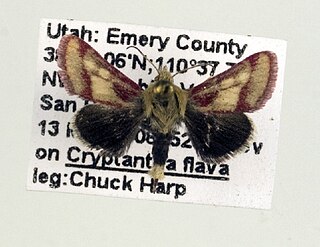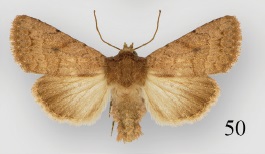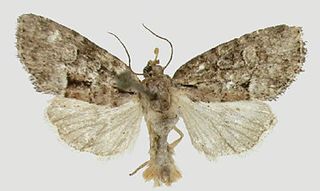External links
- Images
- Nomenclatural validation of three North American species of Heliothinae (Lepidoptera: Noctuidae) and the adult description of Heliolonche joaquinensis Hardwick
| Heliolonche joaquinensis | |
|---|---|
| Scientific classification | |
| Kingdom: | |
| Phylum: | |
| Class: | |
| Order: | |
| Family: | |
| Genus: | |
| Species: | H. joaquinensis |
| Binomial name | |
| Heliolonche joaquinensis Hardwick, 1996 | |
Heliolonche joaquinensis is a species of moth of the family Noctuidae. It is found in the San Joaquin Valley from San Benito and Fresno counties in the north and Kern and Santa Barbara counties in the south.
The length of the forewings is 8.5–9 mm for males and 8–9 mm for females. Adults are on wing from March to May.

Heliolonche is a genus of moths of the family Noctuidae.

Actebia fennica, the black army cutworm or Eversmann's rustic, is a moth of the family Noctuidae. The species was first described by August Michael Tauscher in 1806. It has a Holarctic distribution from Newfoundland through western Europe, Siberia, the Far East, Mongolia, northern China to Korea and Japan. In North America it is mainly found in the boreal region, south to New England, southern Montana and northern Oregon.
Hypocoena rufostrigata is a species of moth of the family Noctuidae first described by Alpheus Spring Packard in 1867. It is found along the Atlantic coast of North America north to the Northwest Territories and Alaska, south in the west to California and Utah.
Bryolymnia viridata is a moth of the family Noctuidae first described by Leon F. Harvey in 1876. It is found in the US in western California from Sonoma County north of San Francisco southward to San Diego County.

Diachrysia balluca, the green-patched looper, is a moth of the family Noctuidae. The species was first described by Carl Geyer in 1832. It is found in north-eastern North America from Nova Scotia west to Manitoba and south to western North Carolina. Great Smoky Mountains National Park is the southern limit of this species. The only other records in the south are from the type locality of Georgia and a record from Liberty County in north-western Florida. These possibly represent strays.

Euxoa adumbrata, the sordid dart, is a moth of the family Noctuidae. The species was first described by Eduard Friedrich Eversmann in 1842. In North America it is found across northern Canada from Quebec to western Alaska, south to the northern parts of the United States, and in the mountains to Colorado. It is also found in Greenland, the coastal areas of Scandinavia and the Ural. It was recently recorded from Denmark, although this includes Euxoa lidia, which some authors regard to be a valid species.

Heliothinae is a small subfamily of moths in the family Noctuidae. There are about 400 species described worldwide. They are found more commonly found in partially dry areas of subtropical habitats.
Heliolonche modicella is a species of moth of the family Noctuidae. It is found in North America, including California.

Heliolonche carolus is a species of moth of the family Noctuidae. It is found in North America, including California and Arizona.

Heliolonche pictipennis is a species of moth of the family Noctuidae. It is found in North America, including California and Arizona.
Lasionycta poca is a moth of the family Noctuidae first described by William Barnes and Foster Hendrickson Benjamin in 1923. It is found throughout the Rocky Mountains of Alberta, westward to the Coast Range in western British Columbia and southward in the Cascades to Okanogan County, Washington.
Psammopolia insolens is a moth of the family Noctuidae. It occurs on Pacific Coast sand beaches in central California from Carmel to Bodega Bay, Sonoma County. Most specimens are from near San Francisco.
Charadra moneta is a moth of the family Noctuidae. It is found from central and eastern Arizona, the San Mateo Mountains of New Mexico, the Guadalupe Mountains of New Mexico and Texas, and the Big Bend region of Texas; south to the Sierra Madre in Nuevo León, northern Mexico.
Charadra dispulsa is a moth of the family Noctuidae. Its range spans from Texas southward and westward to at least San Luis Potosí, Mexico.

The Erebidae are a family of moths in the superfamily Noctuoidea. The family is among the largest families of moths by species count and contains a wide variety of well-known macromoth groups. The family includes the underwings (Catocala); litter moths (Herminiinae); tiger, lichen, and wasp moths (Arctiinae); tussock moths (Lymantriinae), including the arctic woolly bear moth ; piercing moths ; micronoctuoid moths (Micronoctuini); snout moths (Hypeninae); and zales, though many of these common names can also refer to moths outside the Erebidae. Some of the erebid moths are called owlets.
Apantesis edwardsii is a moth of the family Erebidae. It was described by Stretch in 1872. It is known only from the San Francisco area in California and Klamath County in Oregon.
Apantesis ursina is a moth of the family Erebidae. It was described by Schmidt in 2009. It is found on the Channel Islands off the coast of southern California and in mainland south-western California from Kern County south to San Diego County. It is probably also present in Baja California.

Nudorthodes variabilis is a moth in the family Noctuidae first described by William Barnes and James Halliday McDunnough in 1912. It is found in the US along the coast of southern California, from Santa Barbara County to San Diego County.

Cherokeea attakullakulla is a moth in the family Noctuidae and the only species in the genus Cherokeea. It is found in North Carolina and Georgia.

Aseptis ferruginea is a moth of the family Noctuidae first described by Tomas Mustelin in 2000. It is endemic to southern California. All records are from San Diego County, from an area between Boulevard-Manzanita near the Mexican border north to Lake Henshaw at altitudes of 800–1600 meters. The habitat consist of open oak forest, foothill chaparral, and in the mountain-desert transition zone.